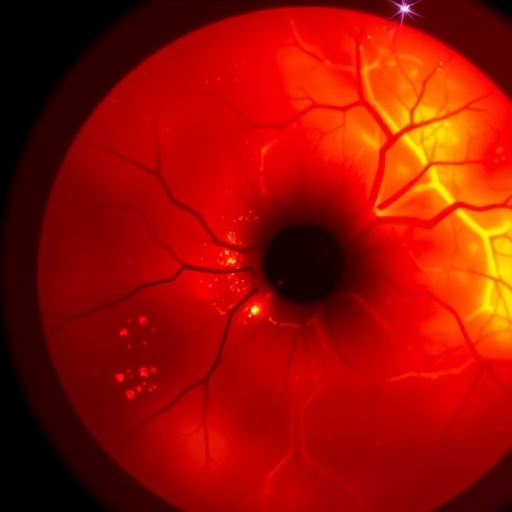In a groundbreaking study published in Cell Death Discovery, researchers led by Li et al. have unveiled a promising therapeutic avenue for combating subretinal fibrosis, a devastating pathological process linked with vision loss in retinal diseases. Their work centers on the inhibition of Rho-associated protein kinase (ROCK), a molecular player intricately involved in cellular dynamics, fibrosis, and inflammation in the retina. This new insight into Rho-kinase’s role opens compelling possibilities for targeted intervention in subretinal scarring, offering hope to millions affected by age-related macular degeneration (AMD) and other fibrotic retinal disorders.
Subretinal fibrosis is a hallmark of late-stage neovascular AMD and other chronic retinal diseases, characterized by the excessive deposition of extracellular matrix components beneath the retina. This fibrotic scarring disrupts the delicate retinal architecture, causing irreversible vision impairment. Traditional therapies have focused primarily on halting neovascular growth but have failed to effectively address fibrosis. Li and colleagues’ research provides a critical mechanistic understanding of how ROCK inhibition can attenuate fibrosis and preserve retinal function.
The Rho-kinase signaling pathway regulates cytoskeletal organization, cell motility, and contractility—all functions crucial to the fibrotic process. By pharmacologically inhibiting ROCK, the researchers demonstrated a significant reduction in fibrotic markers and extracellular matrix deposition in experimental models of subretinal fibrosis. These findings highlight the pathway’s pivotal regulatory role in fibrogenic cell phenotypes within the retinal microenvironment, marking ROCK as a viable molecular target.
The study employed sophisticated in vivo and in vitro approaches to dissect the molecular underpinnings of ROCK-mediated fibrosis. Using retinal pigment epithelial cells and fibroblast cultures, the authors showed that ROCK inhibition suppressed the transformation of these cells into myofibroblasts, the primary effector cells driving fibrosis. This phenotypic modulation was accompanied by downregulation of alpha-smooth muscle actin (α-SMA) and collagen synthesis, hallmark indicators of reduced fibrotic activity.
Importantly, the researchers leveraged animal models that recapitulate human subretinal fibrosis, allowing for precise evaluation of therapeutic potential. Administration of ROCK inhibitors in these models resulted in notable mitigation of fibrotic lesion size and improved retinal morphology. Functional assessments revealed preserved retinal electrophysiology and visual function, underscoring the clinical relevance of targeting ROCK in fibrotic retinal disease.
The implications of this study extend beyond subretinal fibrosis, as Rho-kinase signaling is implicated in multiple fibrotic disorders across different tissues. The retina, with its distinct cellular composition and immune privilege, presents unique challenges, but ROCK inhibition appears effective in modulating the fibrogenic cascade specifically in retinal contexts. This specificity may translate into fewer off-target effects and better therapeutic indices for retinal fibrosis patients.
Moreover, the study elucidates the cross-talk between ROCK signaling and inflammatory pathways that exacerbate fibrogenesis. By attenuating pro-inflammatory cytokine production and immune cell infiltration in the subretinal space, ROCK inhibitors help create a microenvironment less conducive to fibrosis. This dual antifibrotic and anti-inflammatory action sets ROCK inhibitors apart from conventional treatments that often neglect the multifactorial nature of retinal scarring.
A notable strength of the research lies in its comprehensive molecular characterization, utilizing transcriptomics and proteomics to map ROCK-dependent gene and protein expression changes linked to fibrosis. These datasets provide a valuable resource for identifying downstream effectors and potential biomarkers for treatment response, accelerating the translational trajectory toward clinical applications.
Challenges remain for the clinical adoption of ROCK inhibitors, including optimization of drug delivery to the subretinal space and minimization of systemic exposure. However, advances in ocular pharmacology, such as sustained-release implants and targeted intravitreal injections, promise to overcome these barriers. Future clinical trials will critically assess efficacy, dosing regimens, and long-term safety of ROCK inhibitor therapies in patients with retinal fibrosis.
This study’s insights also provoke intriguing questions about combinational therapeutic strategies. Since fibrosis often occurs alongside neovascularization, pairing ROCK inhibitors with anti-VEGF agents could offer synergistic benefits, simultaneously halting vessel growth and fibrotic scarring. This multi-modal approach may redefine treatment paradigms and improve visual outcomes in complex retinal diseases.
Li et al.’s findings resonate with a broader scientific push to decode the molecular choreography of fibrosis, one of the leading causes of organ dysfunction worldwide. Their work not only advances the field of ophthalmology but also contributes to the general understanding of ROCK’s role in fibrosis, fostering cross-disciplinary innovations in fibrosis management.
In summary, the study represents a milestone in retinal medicine, shining a spotlight on Rho-kinase inhibition as a formidable strategy to treat subretinal fibrosis—a blinding pathology with few effective therapies. Continued exploration and clinical development are warranted to translate these compelling preclinical findings into tangible vision-saving treatments that could alleviate the global burden of retinal fibrosis.
The revelation that a single kinase pathway modulates both cellular contractility and inflammatory responses in fibrosis is a profound testament to the complexity of fibrotic disease biology. It also showcases how targeted molecular intervention can disrupt maladaptive tissue remodeling, ultimately preserving organ function and patient quality of life. As the research community builds upon these promising results, patients suffering from subretinal fibrosis may soon witness a revolution in retinal therapeutics rooted in molecular precision.
This investigation serves as a beacon for clinicians and scientists alike, underscoring the necessity of integrating molecular research into clinical frameworks. With eye diseases profoundly impacting aging populations worldwide, breakthroughs like ROCK inhibition highlight the transformative potential of bench-to-bedside research in combating visual disability and blindness stemming from fibrosis.
The study’s interdisciplinary approach, combining cell biology, molecular pharmacology, advanced imaging, and functional assessments, epitomizes modern biomedical research’s power. It captures how nuanced insights into cell signaling cascades can yield novel interventional targets with direct implications for human health. This is a compelling paradigm for future investigations across chronic fibrotic conditions beyond ophthalmology.
In closing, Li and colleagues’ research heralds a promising new chapter in the fight against subretinal fibrosis. By illuminating ROCK inhibition’s multifaceted role in modulating fibrosis, the study offers a beacon of hope for developing therapies that preserve sight in patients vulnerable to blinding fibrotic retinal disease, marking a significant stride toward a future where vision loss from fibrosis can be effectively prevented or treated.
Subject of Research: Subretinal fibrosis and its molecular modulation via Rho-kinase inhibition in retinal diseases.
Article Title: Rho-kinase inhibition reduces subretinal fibrosis.
Article References:
Li, Y., Yarahmadov, T., Jahnke, L. et al. Rho-kinase inhibition reduces subretinal fibrosis. Cell Death Discov. 11, 428 (2025). https://doi.org/10.1038/s41420-025-02709-0
Image Credits: AI Generated
DOI: https://doi.org/10.1038/s41420-025-02709-0
Tags: age-related macular degenerationcellular dynamics in retinaextracellular matrix regulationfibrotic retinal disordersneovascular AMD challengespharmacological interventions in fibrosisretinal disease treatmentRho-kinase inhibitionROCK signaling pathwaysubretinal fibrosis therapytherapeutic strategies for retinal healthvision loss prevention





